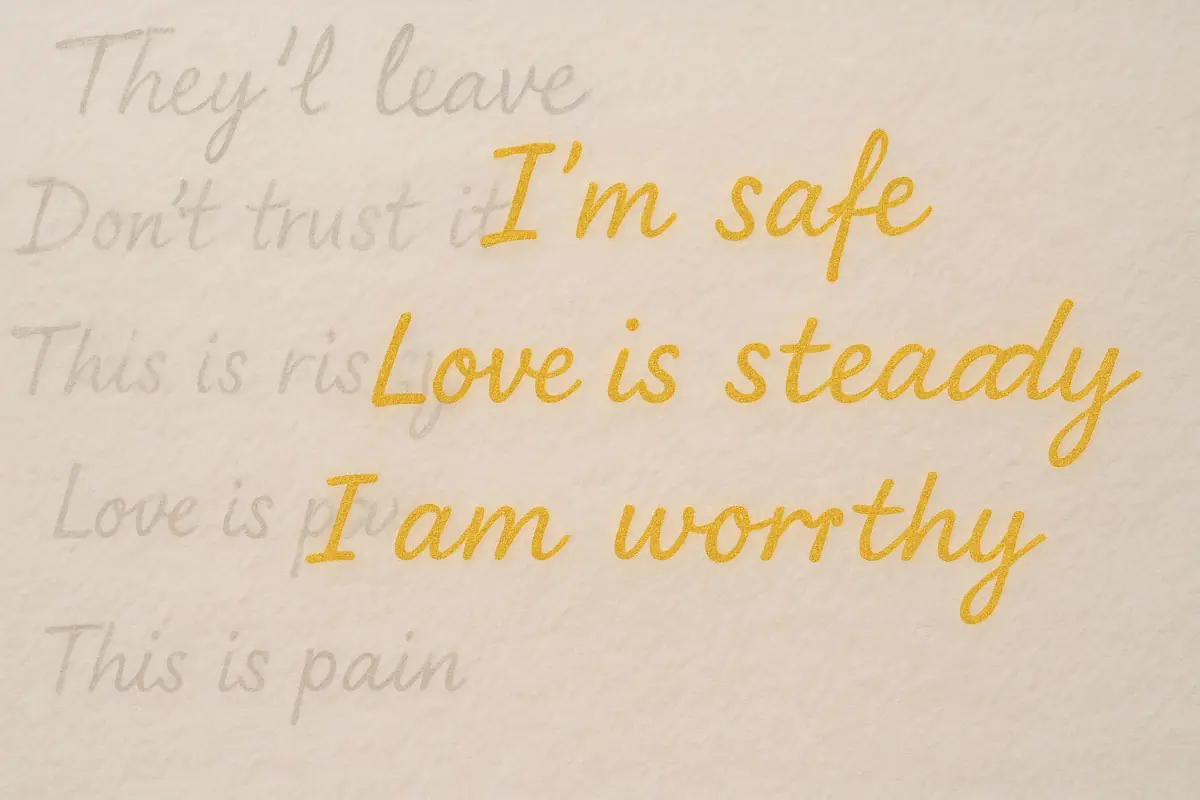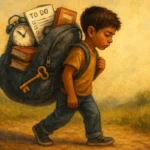The Invisible Script You Didn’t Know You Were Following
How Childhood Experiences Quietly Shape — and Can Transform — Your Adult Relationships
With insights from John Bowlby, Mary Ainsworth, and Sue Johnson, PhD
Prologue: The Night It All Came Back
It was a gray Thursday in November 2020. Outside, rain tapped against Lena’s apartment windows like impatient fingers. She was standing in the kitchen, chopping carrots for soup, her phone face-down on the counter. When it buzzed, she wiped her hands and glanced at the screen. Two words. Running late.
It should have been nothing. A fact, not a threat. But Lena’s throat tightened. Her shoulders curled forward. She wasn’t in her kitchen anymore. She was six years old, in a small, dim apartment kitchen in 1989, knees pulled under her oversized sweater, watching the clock’s red second hand jerk forward.
The tea on the counter had gone cold an hour ago. Her mother’s shift at the diner had ended forty minutes earlier. Some nights, the door would open and her mother’s voice would sing out, “Hey, baby!” Warm arms, cheek pressed against her hair, the world briefly safe. Other nights — the slam of the door, a muttered curse, and the quiet thud of boots disappearing into the bedroom. No explanation. No dinner. No smile. The rules were never written down, but Lena had memorized them: Don’t expect. Don’t ask. Don’t need too much.
Back in 2020, she set her phone down, but her body was already bracing — heart thudding, breath shallow, a silent alarm wired three decades ago.
John Bowlby: The Man Who Saw the Thread
In the late 1940s, British psychiatrist John Bowlby walked through postwar orphanages and children’s hospitals. He saw little ones with food in their bellies and roofs over their heads — yet their eyes were empty, their play gone. Some turned their faces to the wall when approached, as if they’d decided love was not just absent, but dangerous.
Bowlby began to see the thread: Humans are born with an attachment system, a radar always scanning for safety. When the signal is strong, children can explore, laugh, grow. When it’s weak or erratic, survival kicks in: cling harder, cry louder, or go quiet and self-reliant before they can even spell those words. He argued something revolutionary: Love wasn’t a luxury. It was survival.
Flashback One: The First Rule
It was winter 1989. The radiator clanked but never gave enough heat. Lena sat at the kitchen table, drawing on scrap paper from the diner. Her mother came in late, smelling of fryer oil and Marlboros. No “Hey, baby” this time. She dropped her purse on the counter, pulled off her boots, and lit a cigarette without looking up. Lena held up her drawing — a picture of the two of them holding hands. Her mother glanced once, then exhaled smoke and said, “Not now, Lena. Mama’s tired.” The paper went limp in her hands. Rule number one wrote itself: Don’t bother her when she’s tired.
Mary Ainsworth: The Woman Who Made It Visible
Decades after Bowlby’s first papers, Canadian psychologist Mary Ainsworth wanted proof you could see with your own eyes. She created the Strange Situation experiment in the 1970s: a mother and toddler in a room. The mother leaves. The mother returns. Some children ran to her, melted into her arms, then calmly returned to play — secure. Some clung desperately, unable to settle — anxious. Some acted indifferent, avoiding eye contact — avoidant — but their pounding hearts betrayed their calm facade. Later, a fourth style was named: disorganized — wanting comfort but fearing it at the same time.
Flashback Two: The Second Rule
Summer 1990. The neighbor’s boy, Tommy, had pushed Lena off the swings. She ran home with a bloody knee, heart pounding with the certainty that her mother would make it better. But her mother was on the phone, laughing with someone. Lena tugged at her sleeve. Her mother covered the receiver, glanced at the knee, and said, “You’re fine. Go wash it off.” Back to the phone. In the bathroom, Lena rinsed the blood herself, watching it swirl pink in the sink. Rule number two: Don’t expect comfort. Handle it yourself.
The Four Invisible Blueprints
By adulthood, these early lessons harden into attachment styles:
- Secure: Care is consistent. You trust closeness.
- Anxious: Care is unpredictable. You grip love tightly, afraid it will vanish.
- Avoidant: Care is distant. You protect yourself by needing no one.
- Disorganized: Care is tangled with fear. You want closeness but expect pain.
Lena’s blueprint was anxious. Love could fill her up or freeze her out — and she needed to be ready for either.
The Breaking Point
It was a rainy night in April 2020. Mark had stopped for groceries after work. When he came in an hour later than she expected, Lena’s questions were sharp. Her tone, colder than she meant. Mark stood in the doorway, grocery bag in hand, and said quietly, “I feel like you’re always waiting for me to hurt you. And I don’t know how to prove I won’t.” Something inside her crumpled. He was right. And she had no idea how to stop.
Enter Sue Johnson: The Rewrite Artist
If Bowlby discovered the blueprint, and Ainsworth mapped the floor plan, Sue Johnson, PhD shows people how to rebuild the house. A clinical psychologist and creator of Emotionally Focused Therapy (EFT), Johnson’s core message is this: The same deep need for safety we had in the crib still lives in us now. And it can be healed — not by pretending we don’t need love, but by learning to reach and respond differently. Her work gave Lena a word she’d never heard before: earned secure attachment. It meant she could change her relational wiring — even if the first draft had been written in neglect.
Step One: Notice Your Triggers
The first thing Lena’s therapist taught her was to pause when her body went into alarm. The next time Mark was late, she felt the knot in her stomach, the prickling heat in her face. Instead of firing off a text, she closed her eyes. And there was the kitchen. The waiting. The not knowing.
EFT Tapping for This Step:
Setup: “Even though noticing my fear feels dangerous, I’m open to the idea that I can witness it now without being swallowed whole.”
Sequence:
- Eyebrow: “This fear in my chest…”
- Side Eye: “It feels too big…”
- Under Eye: “Like I’ll lose control…”
- Chin: “But I’m not that child anymore…”
- Collarbone: “It’s safe to notice…”
- Top Head: “I can be here with myself now.”
Step Two: Name and Share Your Needs
It took weeks before Lena could look at Mark and say, “When you don’t text, I get scared I don’t matter.” Her voice shook. Her stomach clenched. She expected irritation, dismissal — maybe silence. Instead, Mark reached for her hand. “I can do better about letting you know. You do matter.” Something in her shoulders eased, like a fist unclenching.
EFT Tapping for This Step:
Setup: “Even though saying my needs out loud feels like I’m risking love, I’m open to believing my needs are worthy of being heard.”
Step Three: Practice Responsiveness
Some nights, Mark was the one who needed comfort. The old Lena would have pulled away — protecting herself from emotional weight. But now, she stayed. Listened. Placed her hand over his. It felt dangerous at first. Then warm. Then right.
EFT Tapping for This Step:
Setup: “Even though closeness used to mean danger, I’m open to the idea that it can feel safe now.”
The New Script
By October 2020, Mark was late again. The text came: Running late. The old fear stirred. She felt the knot begin to form. But Lena paused. Breathed. Tapped. She typed back: Okay. See you soon. When he walked in twenty minutes later, she kissed him on the cheek and went back to stirring soup. It wasn’t that the fear had vanished. It was that it no longer got to steer.
Final Words
Bowlby showed us love is survival. Ainsworth showed us the patterns we carry. Johnson shows us we can change them. Your past explains your patterns. It doesn’t have to define your future. One day, you’ll notice: Your heart no longer braces for impact. It simply beats, steady and sure, in the presence of love.



